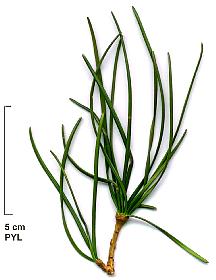Sciadopitys verticillata
Umbrella Pine of Japan 
Particular family, close to Taxodiaceae (Taxodium)

Etymology: the name comes from the Greek sciado, meaning "shade" and pitys, meaning "pine", because its leaves (in fact, false leaves) resemble needles of the pine ; the specific epithet verticillata means "with whorls".
Origin: discovered in Japan in 1775 by Carl Thunberg, doctor of the Dutch company of oriental India and pupil of Linné. ignoring the genus, he allocates it as the yew tree and names it taxus verticillata. His successor, Siebold, created the new genus.
Habitat: tree of humid forests. it supports shade.
Height: It attains 40 m in Japan, and, for the moment, 20 m in Europe.
Shape: pyramidal. Dense crown, low branches.
Right trunk, several trunks.
Bark: reddish-brown-red, peeling off in vertical rags.
Persistent foliage : they are not real leaves, but cladophylls, cladodes or phylloclades ("leaf-like branches") which are portions of a stem that resemble leaves and replace them as the main photosynthetic organs of the plan. 7-15 cm long, supples, green shining on the top, clear on underside, grouped in whorl, at the end of the new stems, and persisting 3 years. If the false leaf is torn on its length, one point out that every half leaf contains distinct vascular bundles, as though, at origin, the false leaf was formed of 2 leaves which merged.
Flowers: male cones in clusters of 10-15, yellow, 2,5 cm.
Fruits: ovoid cones, of 5-8 cm, maturing in 2 years.
Use: ornamental tree in Europe. Its whitish, satiny, good quality, elastic, lasting wood, is very used in Japan (pieces of furniture, barrels); the bark serves for braiding cordage. |